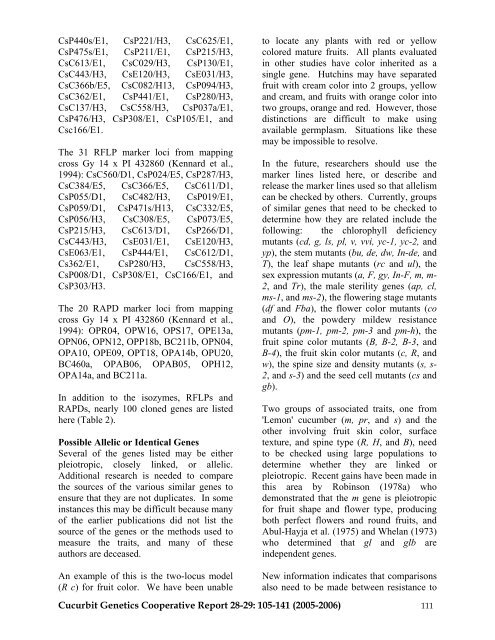Complete volume with articles 1 to 32 - Cucurbit Breeding - North ...
Complete volume with articles 1 to 32 - Cucurbit Breeding - North ...
Complete volume with articles 1 to 32 - Cucurbit Breeding - North ...
Create successful ePaper yourself
Turn your PDF publications into a flip-book with our unique Google optimized e-Paper software.
CsP440s/E1, CsP221/H3, CsC625/E1,<br />
CsP475s/E1, CsP211/E1, CsP215/H3,<br />
CsC613/E1, CsC029/H3, CsP130/E1,<br />
CsC443/H3, CsE120/H3, CsE031/H3,<br />
CsC366b/E5, CsC082/H13, CsP094/H3,<br />
CsC362/E1, CsP441/E1, CsP280/H3,<br />
CsC137/H3, CsC558/H3, CsP037a/E1,<br />
CsP476/H3, CsP308/E1, CsP105/E1, and<br />
Csc166/E1.<br />
The 31 RFLP marker loci from mapping<br />
cross Gy 14 x PI 4<strong>32</strong>860 (Kennard et al.,<br />
1994): CsC560/D1, CsP024/E5, CsP287/H3,<br />
CsC384/E5, CsC366/E5, CsC611/D1,<br />
CsP055/D1, CsC482/H3, CsP019/E1,<br />
CsP059/D1, CsP471s/H13, CsC3<strong>32</strong>/E5,<br />
CsP056/H3, CsC308/E5, CsP073/E5,<br />
CsP215/H3, CsC613/D1, CsP266/D1,<br />
CsC443/H3, CsE031/E1, CsE120/H3,<br />
CsE063/E1, CsP444/E1, CsC612/D1,<br />
Cs362/E1, CsP280/H3, CsC558/H3,<br />
CsP008/D1, CsP308/E1, CsC166/E1, and<br />
CsP303/H3.<br />
The 20 RAPD marker loci from mapping<br />
cross Gy 14 x PI 4<strong>32</strong>860 (Kennard et al.,<br />
1994): OPR04, OPW16, OPS17, OPE13a,<br />
OPN06, OPN12, OPP18b, BC211b, OPN04,<br />
OPA10, OPE09, OPT18, OPA14b, OPU20,<br />
BC460a, OPAB06, OPAB05, OPH12,<br />
OPA14a, and BC211a.<br />
In addition <strong>to</strong> the isozymes, RFLPs and<br />
RAPDs, nearly 100 cloned genes are listed<br />
here (Table 2).<br />
Possible Allelic or Identical Genes<br />
Several of the genes listed may be either<br />
pleiotropic, closely linked, or allelic.<br />
Additional research is needed <strong>to</strong> compare<br />
the sources of the various similar genes <strong>to</strong><br />
ensure that they are not duplicates. In some<br />
instances this may be difficult because many<br />
of the earlier publications did not list the<br />
source of the genes or the methods used <strong>to</strong><br />
measure the traits, and many of these<br />
authors are deceased.<br />
An example of this is the two-locus model<br />
(R c) for fruit color. We have been unable<br />
<strong>to</strong> locate any plants <strong>with</strong> red or yellow<br />
colored mature fruits. All plants evaluated<br />
in other studies have color inherited as a<br />
single gene. Hutchins may have separated<br />
fruit <strong>with</strong> cream color in<strong>to</strong> 2 groups, yellow<br />
and cream, and fruits <strong>with</strong> orange color in<strong>to</strong><br />
two groups, orange and red. However, those<br />
distinctions are difficult <strong>to</strong> make using<br />
available germplasm. Situations like these<br />
may be impossible <strong>to</strong> resolve.<br />
In the future, researchers should use the<br />
marker lines listed here, or describe and<br />
release the marker lines used so that allelism<br />
can be checked by others. Currently, groups<br />
of similar genes that need <strong>to</strong> be checked <strong>to</strong><br />
determine how they are related include the<br />
following: the chlorophyll deficiency<br />
mutants (cd, g, ls, pl, v, vvi, yc-1, yc-2, and<br />
yp), the stem mutants (bu, de, dw, In-de, and<br />
T), the leaf shape mutants (rc and ul), the<br />
sex expression mutants (a, F, gy, In-F, m, m-<br />
2, and Tr), the male sterility genes (ap, cl,<br />
ms-1, and ms-2), the flowering stage mutants<br />
(df and Fba), the flower color mutants (co<br />
and O), the powdery mildew resistance<br />
mutants (pm-1, pm-2, pm-3 and pm-h), the<br />
fruit spine color mutants (B, B-2, B-3, and<br />
B-4), the fruit skin color mutants (c, R, and<br />
w), the spine size and density mutants (s, s-<br />
2, and s-3) and the seed cell mutants (cs and<br />
gb).<br />
Two groups of associated traits, one from<br />
'Lemon' cucumber (m, pr, and s) and the<br />
other involving fruit skin color, surface<br />
texture, and spine type (R, H, and B), need<br />
<strong>to</strong> be checked using large populations <strong>to</strong><br />
determine whether they are linked or<br />
pleiotropic. Recent gains have been made in<br />
this area by Robinson (1978a) who<br />
demonstrated that the m gene is pleiotropic<br />
for fruit shape and flower type, producing<br />
both perfect flowers and round fruits, and<br />
Abul-Hayja et al. (1975) and Whelan (1973)<br />
who determined that gl and glb are<br />
independent genes.<br />
New information indicates that comparisons<br />
also need <strong>to</strong> be made between resistance <strong>to</strong><br />
<strong>Cucurbit</strong> Genetics Cooperative Report 28-29: 105-141 (2005-2006) 111
















